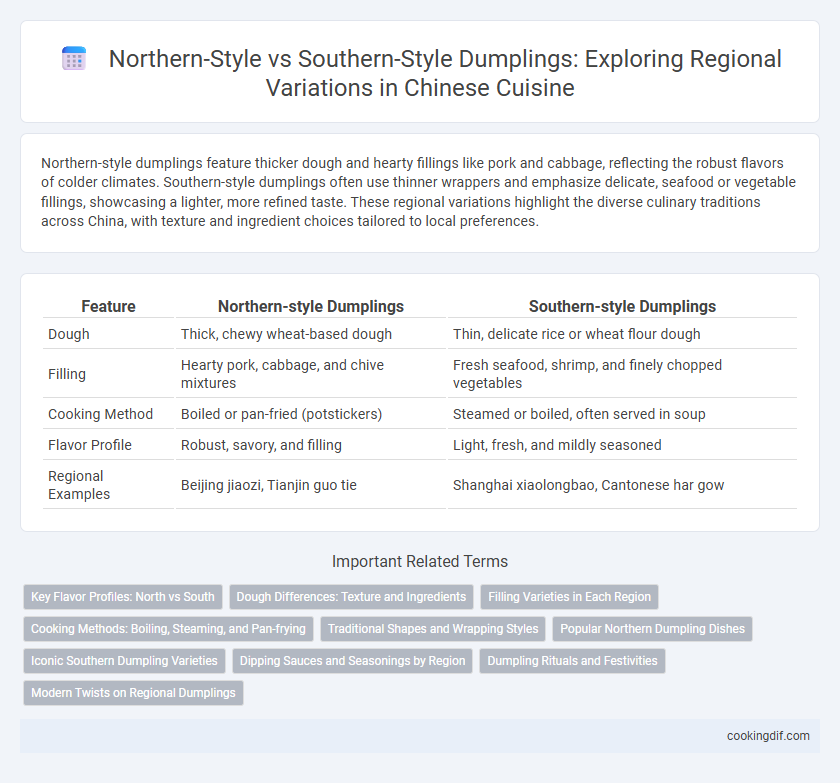Northern-style dumplings feature thicker dough and hearty fillings like pork and cabbage, reflecting the robust flavors of colder climates. Southern-style dumplings often use thinner wrappers and emphasize delicate, seafood or vegetable fillings, showcasing a lighter, more refined taste. These regional variations highlight the diverse culinary traditions across China, with texture and ingredient choices tailored to local preferences.
Table of Comparison
| Feature | Northern-style Dumplings | Southern-style Dumplings |
|---|---|---|
| Dough | Thick, chewy wheat-based dough | Thin, delicate rice or wheat flour dough |
| Filling | Hearty pork, cabbage, and chive mixtures | Fresh seafood, shrimp, and finely chopped vegetables |
| Cooking Method | Boiled or pan-fried (potstickers) | Steamed or boiled, often served in soup |
| Flavor Profile | Robust, savory, and filling | Light, fresh, and mildly seasoned |
| Regional Examples | Beijing jiaozi, Tianjin guo tie | Shanghai xiaolongbao, Cantonese har gow |
Key Flavor Profiles: North vs South
Northern-style dumplings typically feature a robust, savory filling with hearty ingredients such as pork and cabbage, seasoned with garlic and ginger that emphasize bold, umami flavors. Southern-style dumplings often showcase a lighter, sweeter profile with fillings like shrimp and chives, enhanced by subtle aromas of sesame oil and fresh herbs. These regional variations highlight the contrast between the North's rich, intense taste and the South's delicate, fragrant preferences.
Dough Differences: Texture and Ingredients
Northern-style dumplings feature a thicker, chewier dough made primarily from wheat flour and water, giving them a hearty texture ideal for boiling or steaming. Southern-style dumplings often incorporate rice flour or use thinner dough with added lard or oil, resulting in a softer, more delicate texture suited for pan-frying or soup-based dishes. These regional dough variations reflect the culinary preferences and ingredient availability unique to northern and southern China.
Filling Varieties in Each Region
Northern-style dumplings feature fillings rich in pork, cabbage, and garlic chives, reflecting the hearty flavors and colder climate of Northern China. In contrast, Southern-style dumplings emphasize seafood, shrimp, and fresh vegetables like bamboo shoots and water chestnuts, showcasing the region's coastal abundance and lighter culinary preferences. Both varieties highlight distinct regional ingredients, creating diverse taste profiles and textures unique to their geographic origins.
Cooking Methods: Boiling, Steaming, and Pan-frying
Northern-style dumplings often feature thicker dough and are typically boiled or pan-fried, resulting in a chewy texture and crispy bottom; this method highlights the dough's robustness and savory fillings like pork and cabbage. Southern-style dumplings usually have thinner wrappers and are commonly steamed or lightly pan-fried, producing a delicate, tender bite with fillings such as shrimp and chives. The choice of cooking method--boiling, steaming, or pan-frying--directly influences the dumpling's texture and flavor profile, emphasizing regional culinary preferences in China.
Traditional Shapes and Wrapping Styles
Northern-style dumplings typically feature thicker wrappers folded into crescent shapes with pleated edges, designed to hold hearty fillings such as pork and cabbage. Southern-style dumplings often use thinner, more delicate wrappers shaped into intricate round or pouch forms, emphasizing seafood and finely minced ingredients. These regional variations in traditional shapes and wrapping styles reflect differences in texture preferences and culinary techniques across China.
Popular Northern Dumpling Dishes
Northern-style dumplings, known for their thicker dough and heartier fillings, often feature popular dishes such as jiaozi stuffed with pork and cabbage or lamb and scallions, emphasizing robust, savory flavors. These dumplings are commonly boiled or pan-fried, showcasing a chewy texture that contrasts with the southern preference for thinner wrappers and delicate fillings like shrimp or minced pork. Regional variations highlight northern dumplings as a staple during Chinese New Year celebrations, symbolizing wealth and unity in the colder northern climates.
Iconic Southern Dumpling Varieties
Southern-style dumplings are characterized by their tender, doughy texture and savory fillings often featuring pork, shrimp, and seasonal vegetables, with iconic varieties like Cantonese har gow and Shanghai soup dumplings (xiaolongbao) celebrated for their delicate wrappers and rich, flavorful fillings. The Cantonese har gow is renowned for its translucent, thin rice flour skin encasing plump shrimp, while xiaolongbao captivates with its thin wheat-based dough surrounding hot, savory broth and minced pork. These Southern dumpling varieties emphasize subtle flavors and refined textures, contrasting with the chewier, often thicker-skinned Northern dumplings.
Dipping Sauces and Seasonings by Region
Northern-style dumplings often feature thicker wrappers and are paired with soy sauce-based dipping sauces enhanced with vinegar and minced garlic, creating a savory and tangy flavor profile. Southern-style dumplings tend to have thinner skins and are commonly served with lighter, sweeter dipping sauces incorporating ingredients like ginger, scallions, and chili oil for a subtle heat. Regional seasonings reflect culinary traditions, with Northern variations emphasizing robust, salty flavors while Southern versions prioritize delicate, aromatic tastes.
Dumpling Rituals and Festivities
Northern-style dumplings often feature thicker dough and are traditionally consumed during the Chinese New Year as part of family reunions, symbolizing wealth and prosperity. Southern-style dumplings tend to have thinner, more delicate wrappers and are integral to the Dragon Boat Festival, where they are steamed or boiled and shared to honor ancestors. Both regional variations embed deep cultural rituals, highlighting unity and respect through the preparation and communal eating of dumplings.
Modern Twists on Regional Dumplings
Northern-style dumplings typically feature thicker, chewier wrappers and hearty fillings like pork and cabbage, while Southern-style varieties often have thinner, delicate skins with shrimp or seafood-based fillings. Modern twists on regional dumplings include fusion ingredients such as truffle oil or kimchi, and creative cooking methods like pan-searing with molecular gastronomy techniques. Innovative chefs blend traditional flavors with contemporary presentation, transforming classic dumplings into gourmet dishes that appeal to diverse palates worldwide.
Northern-style vs Southern-style for regional variation Infographic

 cookingdif.com
cookingdif.com